RENAULT SCENIC 2011 J95 / 3.G Engine And Peripherals EDC16 Injection User Guide
Manufacturer: RENAULT, Model Year: 2011, Model line: SCENIC, Model: RENAULT SCENIC 2011 J95 / 3.GPages: 236, PDF Size: 1.32 MB
Page 11 of 236

13B - 11
DIESEL INJECTION
Fault finding - System operation13B
V10 MR-372-J84-13B150$094.mif
EDC16 INJECTION
Program No.: C1
Vdiag No: 44, 48 and 4C
Multiplex connection between the vehicle's various computers
The Mégane II electronic system is a multiplex network. This enables dialogue between the various vehicle
computers. As a result:
– the activation of the fault warning lights on the instrument panel is performed by the multiplex network, with the
vehicle speed sensor on the gearbox deactivated,
– the vehicle speed signal is transmitted by the ABS-ESP computer via the multiplex network.
The system can inject diesel fuel into the engine at a pressure of up to 1350 bar. Before each operation, check that
the injection rail is depressurised and that the fuel temperature is not too high.
When working on the high pressure injection system, you must follow the cleanliness guidelines and safety advice
specified in this document.
Removal of the internal parts of the pump and injectors is prohibited. Only the fuel flow actuator, the diesel fuel
temperature sensor and the air vent unit can be replaced.
For safety reasons, it is strictly prohibited to undo a high pressure pipe union when the engine is running.
It is not possible to remove the pressure sensor from the fuel rail because this may cause circuit contamination
faults. If the pressure sensor fails, the pressure sensor, the rail and the five high pressure pipes must be replaced.
It is strictly prohibited to remove any injection pump pulley bearing the number 070 575. If the pump needs to be
replaced, replace the pulley.
Supplying + 12 V directly to any component in the system is prohibited.
Ultrasonic decoking and cleaning are prohibited.
Never start the engine unless the battery is connected correctly.
Disconnect the injection computer when carrying out any welding work on the vehicle. IMPORTANT
The engine must not operate with:
– Diesel fuel containing more than 10 % diester,
– Petrol, even in tiny quantities.
Page 12 of 236

13B - 12
DIESEL INJECTION
Fault finding - System operation13B
V10 MR-372-J84-13B150$094.mif
EDC16 INJECTION
Program No.: C1
Vdiag No: 44, 48 and 4C
b) Functions included
Air conditioning management assistance
In the case of vehicles with climate control, the EDC16 system has the option of deactivating the air conditioning via
the UCH, under certain conditions of use:
– when requested by the driver,
– when starting the engine,
– if the engine overheats (in order to reduce the power the engine has to supply),
– when the engine speed is kept at a very high level (to protect the compressor),
– during transition phases (e.g. high acceleration demand for overtaking, anti-stalling and moving off). These
conditions are only taken into account if they do not occur repeatedly, so as to prevent system instabilities (erratic
deactivation),
– when certain faults appear.
Cold loop air conditioning management
The air conditioning is cold loop managed, shared between several computers. The injection computer is
responsible for:
– authorising cold requests according to the refrigerant pressure, the engine coolant temperature and the engine
speed,
– calculating the power absorbed by the compressor (from the refrigerant pressure),
– requesting operation of the fan assembly, from the UPC, according to the vehicle speed, the refrigerant pressure
and the engine coolant temperature.
Page 13 of 236
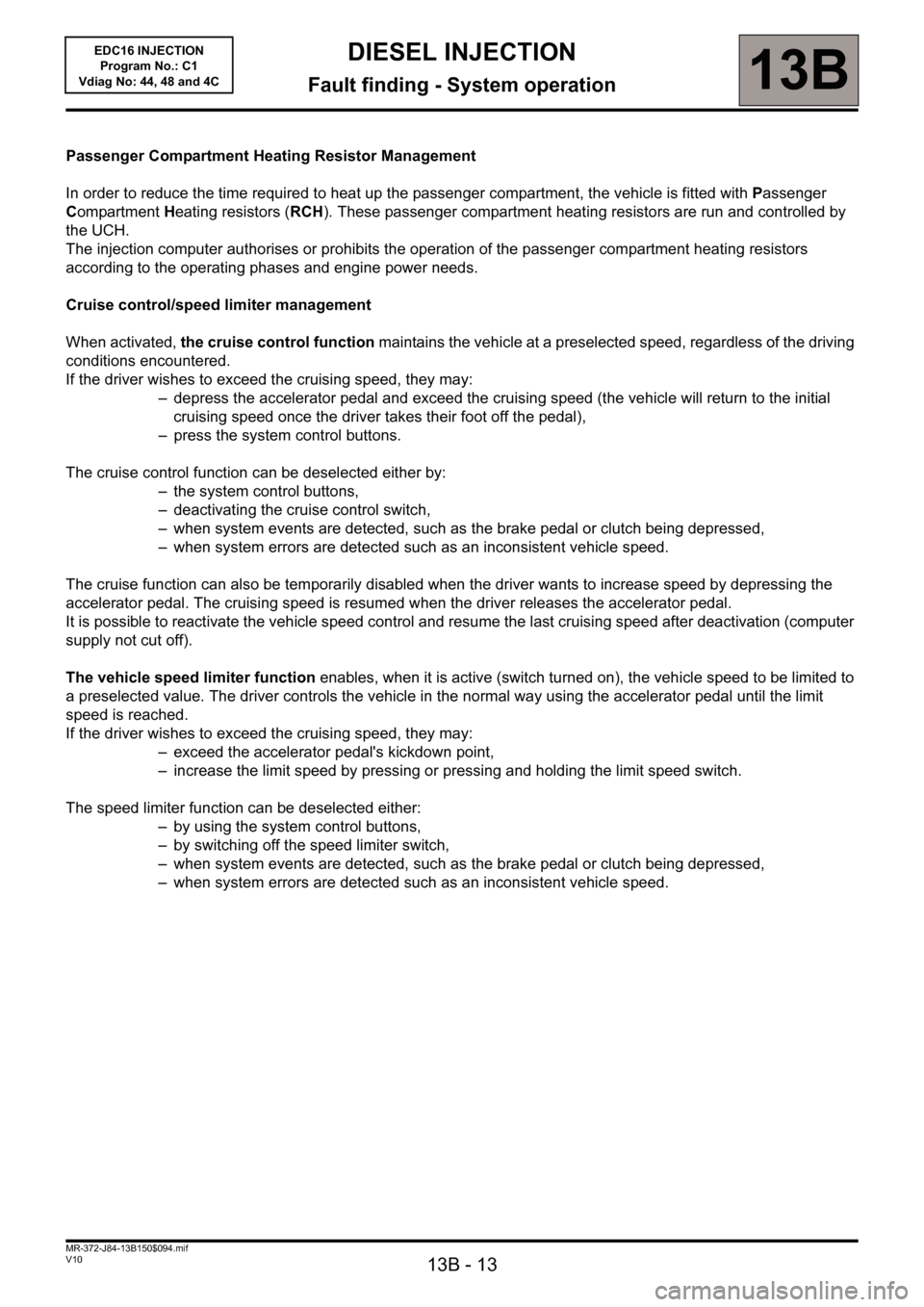
13B - 13
DIESEL INJECTION
Fault finding - System operation13B
V10 MR-372-J84-13B150$094.mif
EDC16 INJECTION
Program No.: C1
Vdiag No: 44, 48 and 4C
Passenger Compartment Heating Resistor Management
In order to reduce the time required to heat up the passenger compartment, the vehicle is fitted with Passenger
Compartment Heating resistors (RCH). These passenger compartment heating resistors are run and controlled by
the UCH.
The injection computer authorises or prohibits the operation of the passenger compartment heating resistors
according to the operating phases and engine power needs.
Cruise control/speed limiter management
When activated, the cruise control function maintains the vehicle at a preselected speed, regardless of the driving
conditions encountered.
If the driver wishes to exceed the cruising speed, they may:
– depress the accelerator pedal and exceed the cruising speed (the vehicle will return to the initial
cruising speed once the driver takes their foot off the pedal),
– press the system control buttons.
The cruise control function can be deselected either by:
– the system control buttons,
– deactivating the cruise control switch,
– when system events are detected, such as the brake pedal or clutch being depressed,
– when system errors are detected such as an inconsistent vehicle speed.
The cruise function can also be temporarily disabled when the driver wants to increase speed by depressing the
accelerator pedal. The cruising speed is resumed when the driver releases the accelerator pedal.
It is possible to reactivate the vehicle speed control and resume the last cruising speed after deactivation (computer
supply not cut off).
The vehicle speed limiter function enables, when it is active (switch turned on), the vehicle speed to be limited to
a preselected value. The driver controls the vehicle in the normal way using the accelerator pedal until the limit
speed is reached.
If the driver wishes to exceed the cruising speed, they may:
– exceed the accelerator pedal's kickdown point,
– increase the limit speed by pressing or pressing and holding the limit speed switch.
The speed limiter function can be deselected either:
– by using the system control buttons,
– by switching off the speed limiter switch,
– when system events are detected, such as the brake pedal or clutch being depressed,
– when system errors are detected such as an inconsistent vehicle speed.
Page 14 of 236
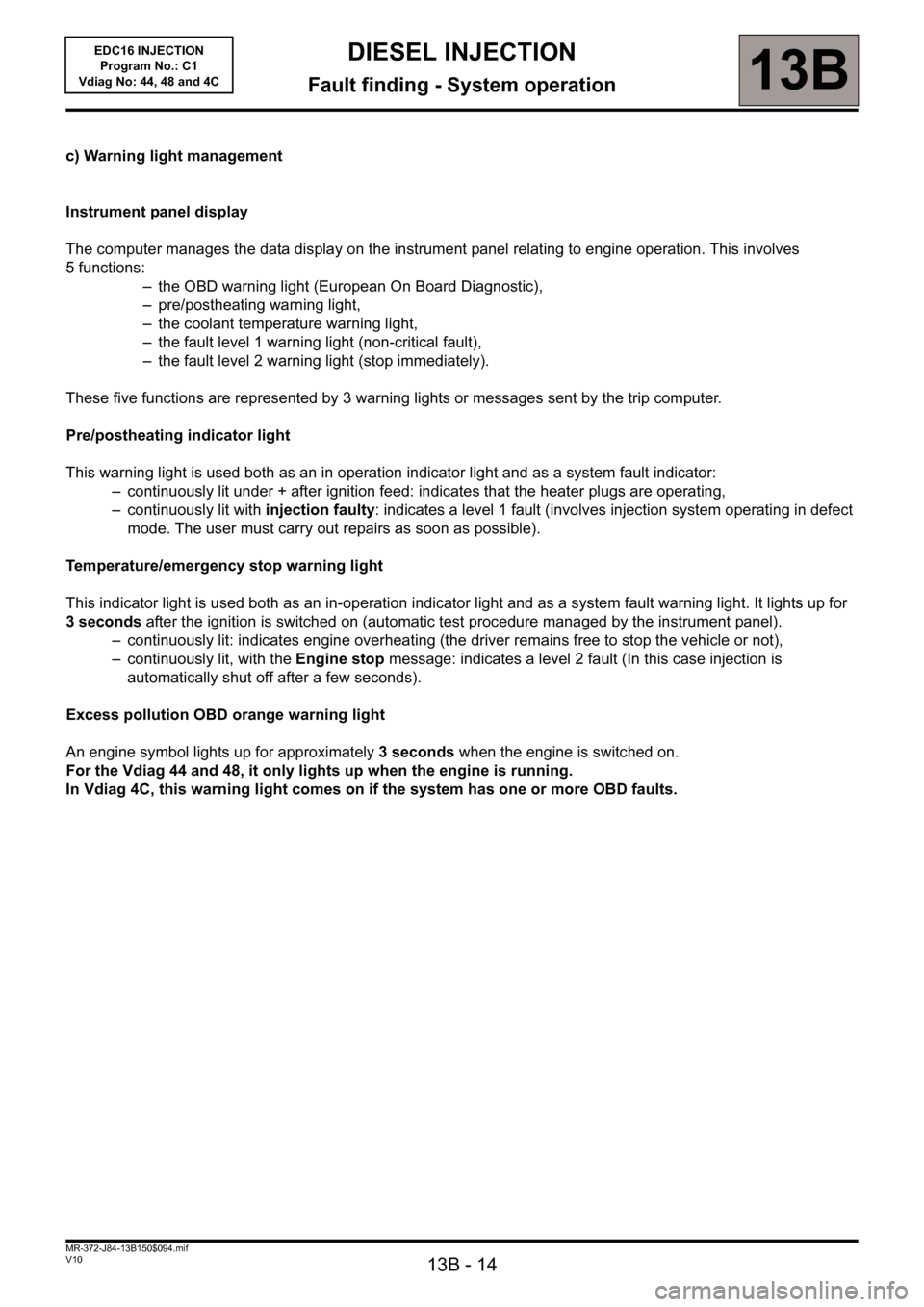
13B - 14
DIESEL INJECTION
Fault finding - System operation13B
V10 MR-372-J84-13B150$094.mif
EDC16 INJECTION
Program No.: C1
Vdiag No: 44, 48 and 4C
c) Warning light management
Instrument panel display
The computer manages the data display on the instrument panel relating to engine operation. This involves
5 functions:
– the OBD warning light (European On Board Diagnostic),
– pre/postheating warning light,
– the coolant temperature warning light,
– the fault level 1 warning light (non-critical fault),
– the fault level 2 warning light (stop immediately).
These five functions are represented by 3 warning lights or messages sent by the trip computer.
Pre/postheating indicator light
This warning light is used both as an in operation indicator light and as a system fault indicator:
– continuously lit under + after ignition feed: indicates that the heater plugs are operating,
– continuously lit with injection faulty: indicates a level 1 fault (involves injection system operating in defect
mode. The user must carry out repairs as soon as possible).
Temperature/emergency stop warning light
This indicator light is used both as an in-operation indicator light and as a system fault warning light. It lights up for
3 seconds after the ignition is switched on (automatic test procedure managed by the instrument panel).
– continuously lit: indicates engine overheating (the driver remains free to stop the vehicle or not),
– continuously lit, with the Engine stop message: indicates a level 2 fault (In this case injection is
automatically shut off after a few seconds).
Excess pollution OBD orange warning light
An engine symbol lights up for approximately 3 seconds when the engine is switched on.
For the Vdiag 44 and 48, it only lights up when the engine is running.
In Vdiag 4C, this warning light comes on if the system has one or more OBD faults.
Page 15 of 236
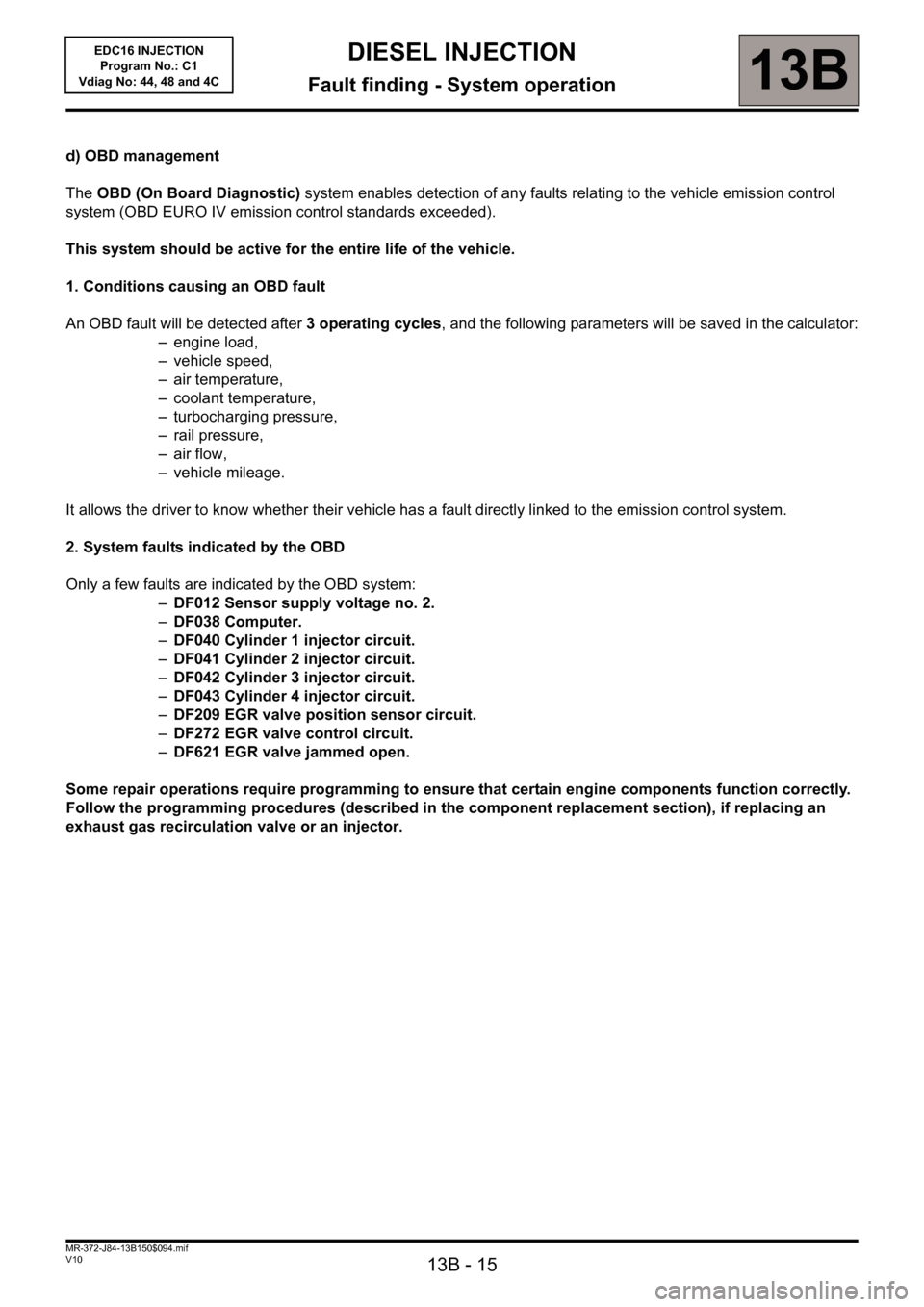
13B - 15
DIESEL INJECTION
Fault finding - System operation13B
V10 MR-372-J84-13B150$094.mif
EDC16 INJECTION
Program No.: C1
Vdiag No: 44, 48 and 4C
d) OBD management
The OBD (On Board Diagnostic) system enables detection of any faults relating to the vehicle emission control
system (OBD EURO IV emission control standards exceeded).
This system should be active for the entire life of the vehicle.
1. Conditions causing an OBD fault
An OBD fault will be detected after 3 operating cycles, and the following parameters will be saved in the calculator:
– engine load,
– vehicle speed,
– air temperature,
– coolant temperature,
– turbocharging pressure,
– rail pressure,
–air flow,
– vehicle mileage.
It allows the driver to know whether their vehicle has a fault directly linked to the emission control system.
2. System faults indicated by the OBD
Only a few faults are indicated by the OBD system:
–DF012 Sensor supply voltage no. 2.
–DF038 Computer.
–DF040 Cylinder 1 injector circuit.
–DF041 Cylinder 2 injector circuit.
–DF042 Cylinder 3 injector circuit.
–DF043 Cylinder 4 injector circuit.
–DF209 EGR valve position sensor circuit.
–DF272 EGR valve control circuit.
–DF621 EGR valve jammed open.
Some repair operations require programming to ensure that certain engine components function correctly.
Follow the programming procedures (described in the component replacement section), if replacing an
exhaust gas recirculation valve or an injector.
Page 16 of 236
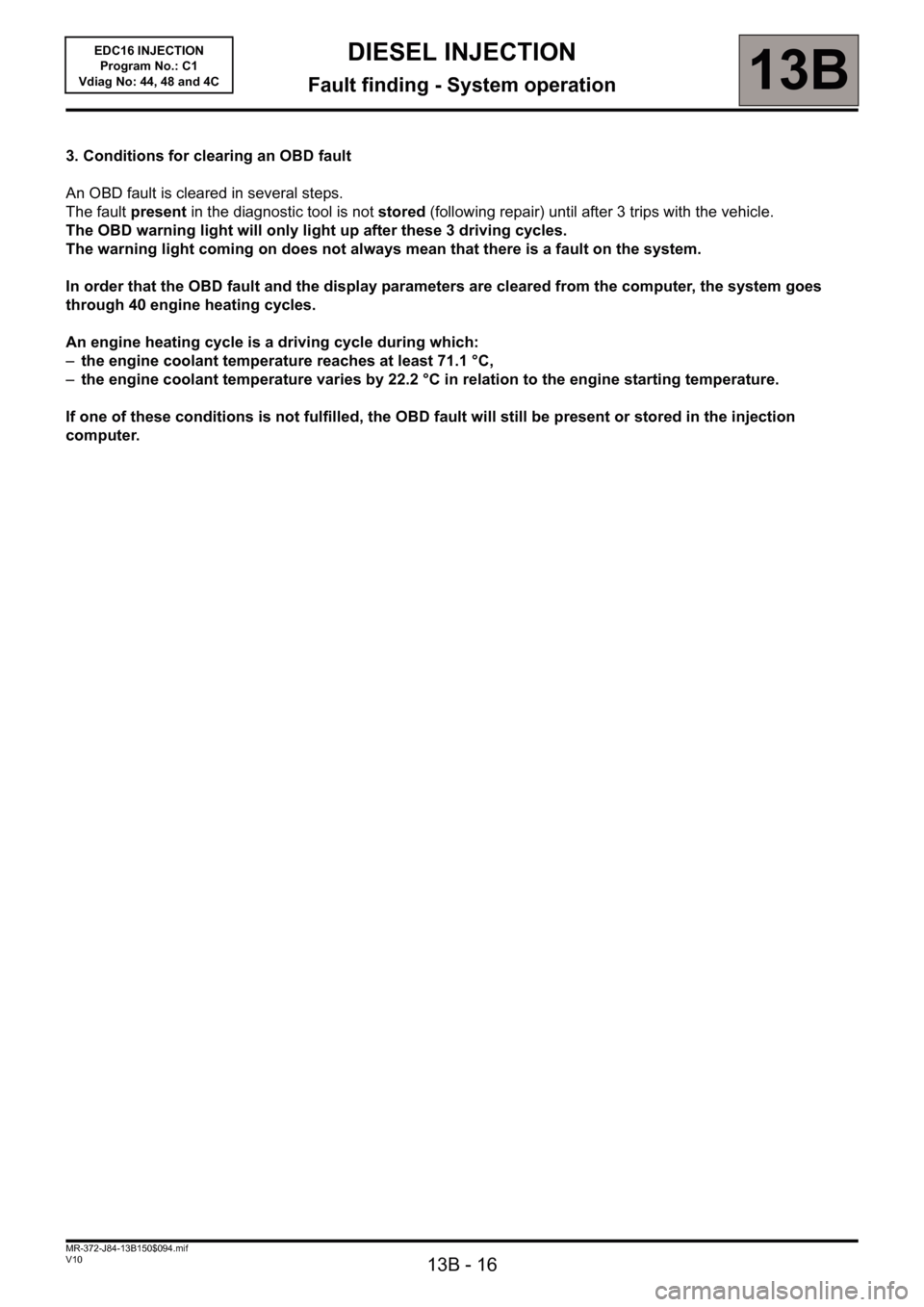
13B - 16
DIESEL INJECTION
Fault finding - System operation13B
V10 MR-372-J84-13B150$094.mif
EDC16 INJECTION
Program No.: C1
Vdiag No: 44, 48 and 4C
3. Conditions for clearing an OBD fault
An OBD fault is cleared in several steps.
The fault present in the diagnostic tool is not stored (following repair) until after 3 trips with the vehicle.
The OBD warning light will only light up after these 3 driving cycles.
The warning light coming on does not always mean that there is a fault on the system.
In order that the OBD fault and the display parameters are cleared from the computer, the system goes
through 40 engine heating cycles.
An engine heating cycle is a driving cycle during which:
–the engine coolant temperature reaches at least 71.1 °C,
–the engine coolant temperature varies by 22.2 °C in relation to the engine starting temperature.
If one of these conditions is not fulfilled, the OBD fault will still be present or stored in the injection
computer.
Page 17 of 236
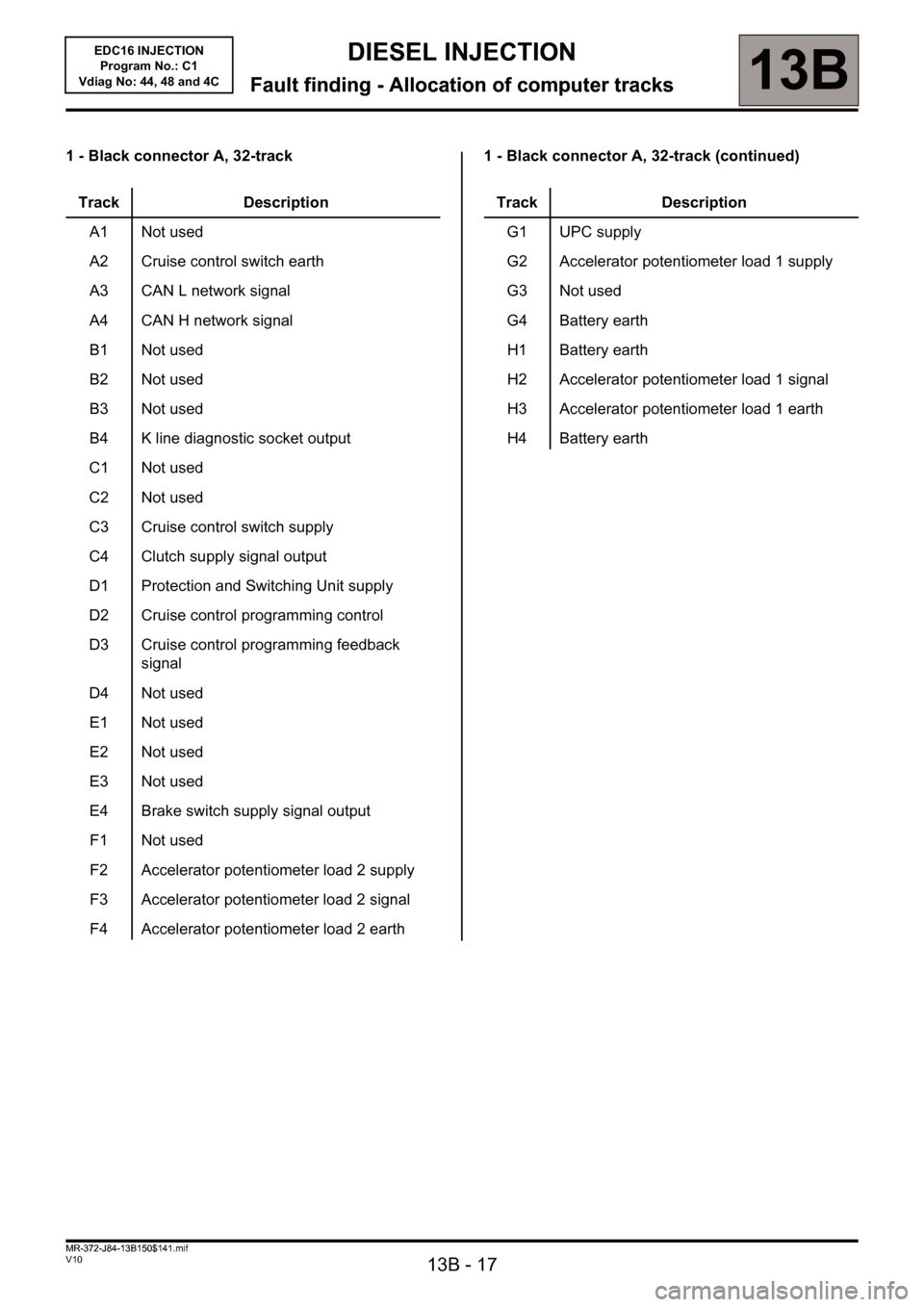
13B - 17
DIESEL INJECTION
Fault finding - Allocation of computer tracks13B
V10 MR-372-J84-13B150$141.mif
EDC16 INJECTION
Program No.: C1
Vdiag No: 44, 48 and 4CDIESEL INJECTION
Fault finding - Allocation of computer tracks
1 - Black connector A, 32-track 1 - Black connector A, 32-track (continued)
Track Description
A1 Not used
A2 Cruise control switch earth
A3 CAN L network signal
A4 CAN H network signal
B1 Not used
B2 Not used
B3 Not used
B4 K line diagnostic socket output
C1 Not used
C2 Not used
C3 Cruise control switch supply
C4 Clutch supply signal output
D1 Protection and Switching Unit supply
D2 Cruise control programming control
D3 Cruise control programming feedback
signal
D4 Not used
E1 Not used
E2 Not used
E3 Not used
E4 Brake switch supply signal output
F1 Not used
F2 Accelerator potentiometer load 2 supply
F3 Accelerator potentiometer load 2 signal
F4 Accelerator potentiometer load 2 earth
Track Description
G1 UPC supply
G2 Accelerator potentiometer load 1 supply
G3 Not used
G4 Battery earth
H1 Battery earth
H2 Accelerator potentiometer load 1 signal
H3 Accelerator potentiometer load 1 earth
H4 Battery earth
MR-372-J84-13B150$141.mif
Page 18 of 236
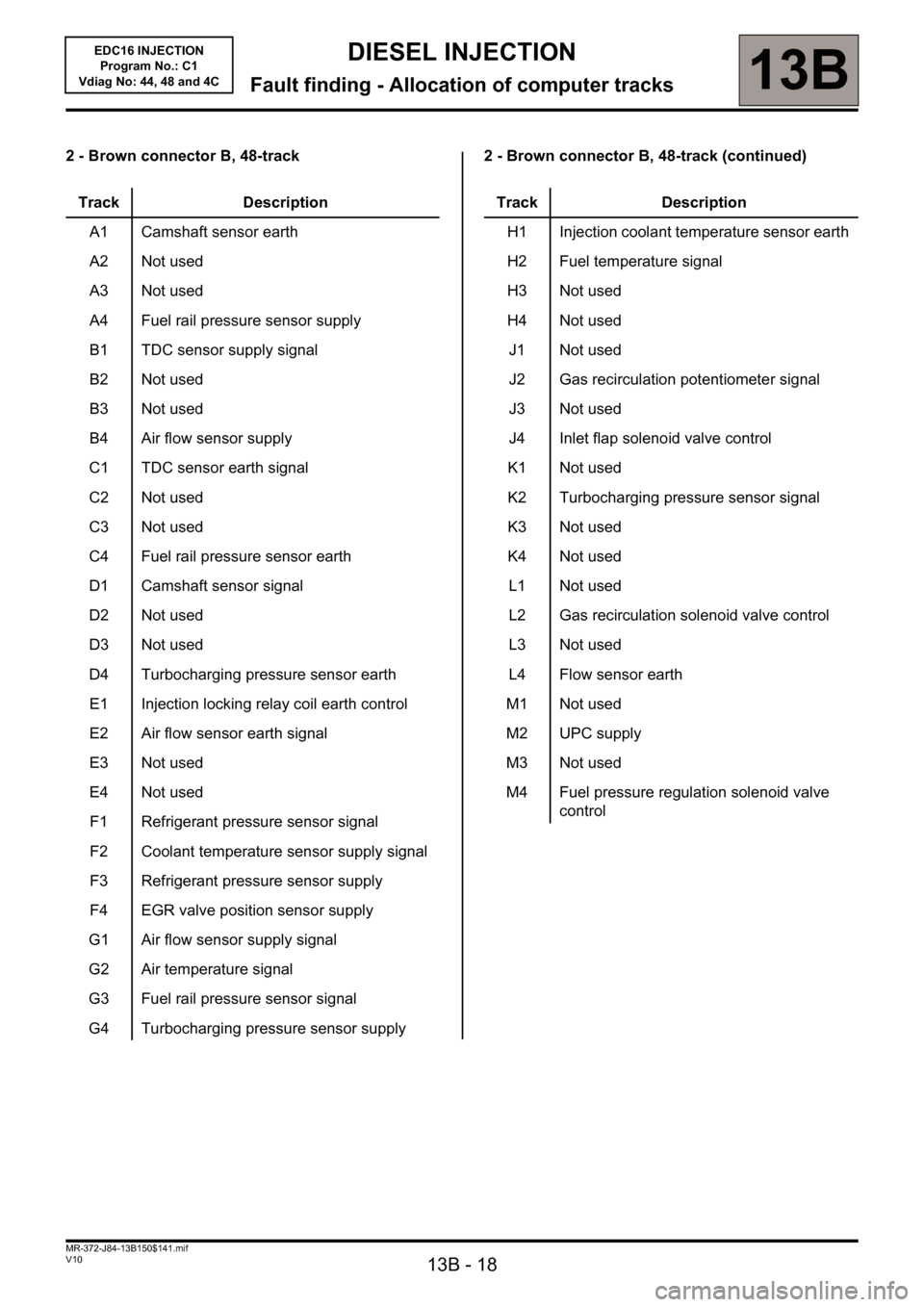
13B - 18
DIESEL INJECTION
Fault finding - Allocation of computer tracks13B
V10 MR-372-J84-13B150$141.mif
EDC16 INJECTION
Program No.: C1
Vdiag No: 44, 48 and 4C
2 - Brown connector B, 48-track 2 - Brown connector B, 48-track (continued)
Track Description
A1 Camshaft sensor earth
A2 Not used
A3 Not used
A4 Fuel rail pressure sensor supply
B1 TDC sensor supply signal
B2 Not used
B3 Not used
B4 Air flow sensor supply
C1 TDC sensor earth signal
C2 Not used
C3 Not used
C4 Fuel rail pressure sensor earth
D1 Camshaft sensor signal
D2 Not used
D3 Not used
D4 Turbocharging pressure sensor earth
E1 Injection locking relay coil earth control
E2 Air flow sensor earth signal
E3 Not used
E4 Not used
F1 Refrigerant pressure sensor signal
F2 Coolant temperature sensor supply signal
F3 Refrigerant pressure sensor supply
F4 EGR valve position sensor supply
G1 Air flow sensor supply signal
G2 Air temperature signal
G3 Fuel rail pressure sensor signal
G4 Turbocharging pressure sensor supply
Track Description
H1 Injection coolant temperature sensor earth
H2 Fuel temperature signal
H3 Not used
H4 Not used
J1 Not used
J2 Gas recirculation potentiometer signal
J3 Not used
J4 Inlet flap solenoid valve control
K1 Not used
K2 Turbocharging pressure sensor signal
K3 Not used
K4 Not used
L1 Not used
L2 Gas recirculation solenoid valve control
L3 Not used
L4 Flow sensor earth
M1 Not used
M2 UPC supply
M3 Not used
M4 Fuel pressure regulation solenoid valve
control
Page 19 of 236
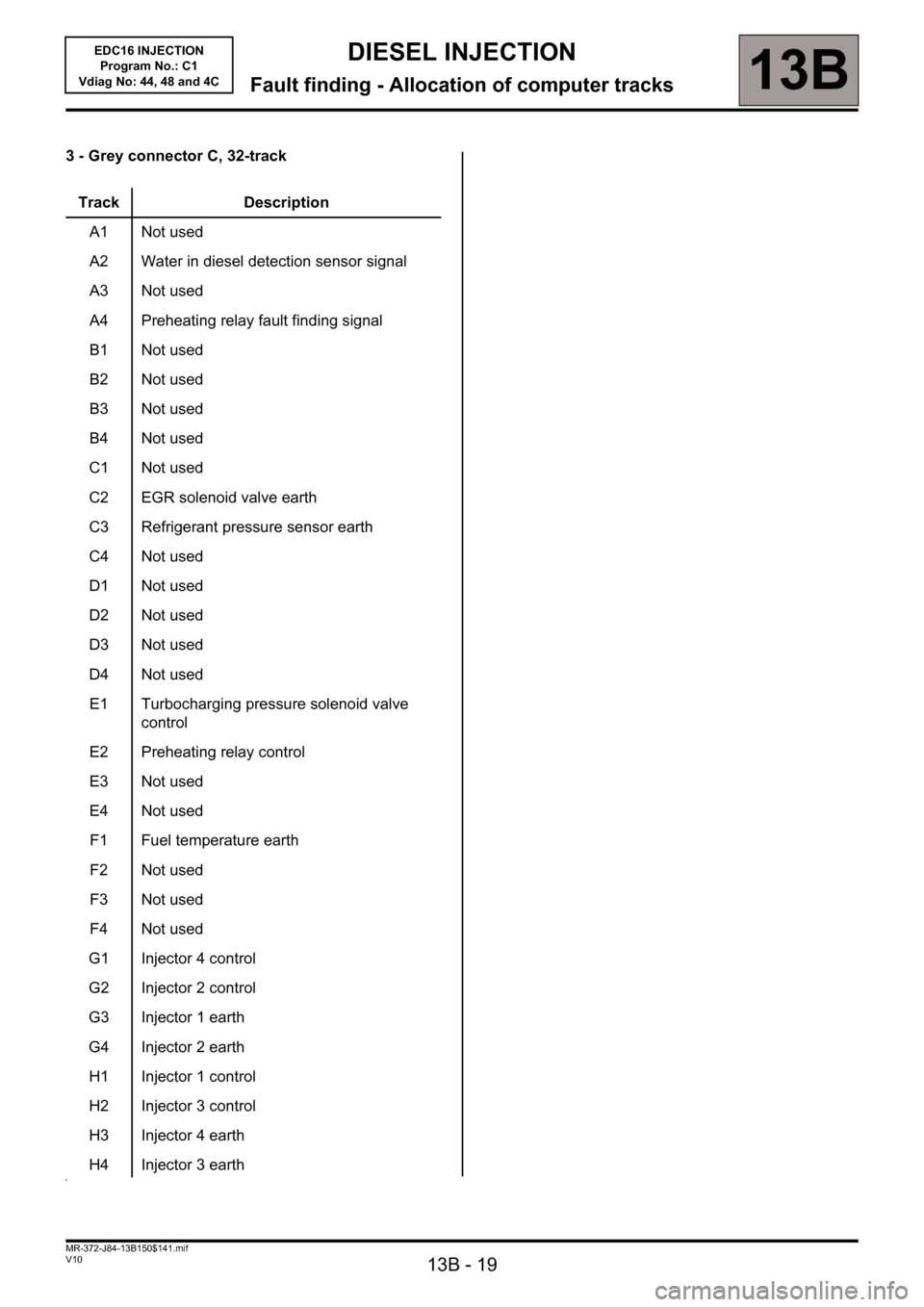
13B - 19
DIESEL INJECTION
Fault finding - Allocation of computer tracks13B
V10 MR-372-J84-13B150$141.mif
EDC16 INJECTION
Program No.: C1
Vdiag No: 44, 48 and 4C
3 - Grey connector C, 32-track
Track Description
A1 Not used
A2 Water in diesel detection sensor signal
A3 Not used
A4 Preheating relay fault finding signal
B1 Not used
B2 Not used
B3 Not used
B4 Not used
C1 Not used
C2 EGR solenoid valve earth
C3 Refrigerant pressure sensor earth
C4 Not used
D1 Not used
D2 Not used
D3 Not used
D4 Not used
E1 Turbocharging pressure solenoid valve
control
E2 Preheating relay control
E3 Not used
E4 Not used
F1 Fuel temperature earth
F2 Not used
F3 Not used
F4 Not used
G1 Injector 4 control
G2 Injector 2 control
G3 Injector 1 earth
G4 Injector 2 earth
H1 Injector 1 control
H2 Injector 3 control
H3 Injector 4 earth
H4 Injector 3 earth
Page 20 of 236
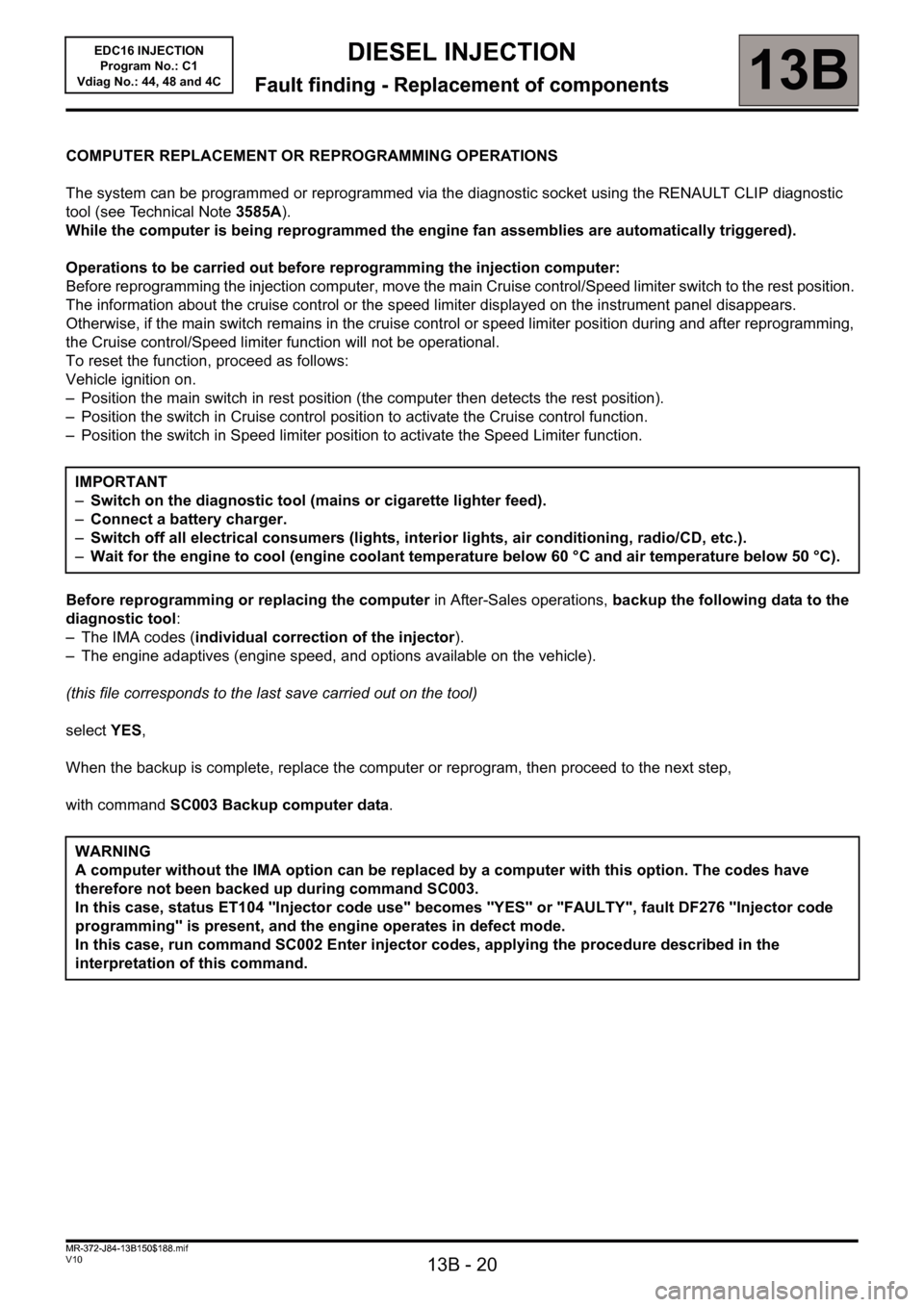
13B - 20
DIESEL INJECTION
Fault finding - Replacement of components13B
V10 MR-372-J84-13B150$188.mif
EDC16 INJECTION
Program No.: C1
Vdiag No.: 44, 48 and 4CDIESEL INJECTION
Fault finding - Replacement of components
COMPUTER REPLACEMENT OR REPROGRAMMING OPERATIONS
The system can be programmed or reprogrammed via the diagnostic socket using the RENAULT CLIP diagnostic
tool (see Technical Note 3585A).
While the computer is being reprogrammed the engine fan assemblies are automatically triggered).
Operations to be carried out before reprogramming the injection computer:
Before reprogramming the injection computer, move the main Cruise control/Speed limiter switch to the rest position.
The information about the cruise control or the speed limiter displayed on the instrument panel disappears.
Otherwise, if the main switch remains in the cruise control or speed limiter position during and after reprogramming,
the Cruise control/Speed limiter function will not be operational.
To reset the function, proceed as follows:
Vehicle ignition on.
– Position the main switch in rest position (the computer then detects the rest position).
– Position the switch in Cruise control position to activate the Cruise control function.
– Position the switch in Speed limiter position to activate the Speed Limiter function.
Before reprogramming or replacing the computer in After-Sales operations, backup the following data to the
diagnostic tool:
– The IMA codes (individual correction of the injector).
– The engine adaptives (engine speed, and options available on the vehicle).
(this file corresponds to the last save carried out on the tool)
select YES,
When the backup is complete, replace the computer or reprogram, then proceed to the next step,
with command SC003 Backup computer data. IMPORTANT
–Switch on the diagnostic tool (mains or cigarette lighter feed).
–Connect a battery charger.
–Switch off all electrical consumers (lights, interior lights, air conditioning, radio/CD, etc.).
–Wait for the engine to cool (engine coolant temperature below 60 °C and air temperature below 50 °C).
WARNING
A computer without the IMA option can be replaced by a computer with this option. The codes have
therefore not been backed up during command SC003.
In this case, status ET104 "Injector code use" becomes "YES" or "FAULTY", fault DF276 "Injector code
programming" is present, and the engine operates in defect mode.
In this case, run command SC002 Enter injector codes, applying the procedure described in the
interpretation of this command.
MR-372-J84-13B150$188.mif